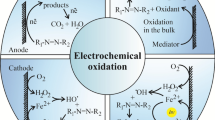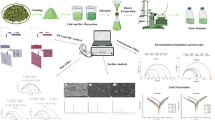Abstract
The potentiometric titration (PT) method has been applied for the first time to investigate the stability of l-ascorbic acid (H2Asc) and to determine its degradation products in aqueous solutions. The presented electrochemical procedures can be considered to be a fast, simple and inexpensive way to control the stability of H2Asc in a regular analytical practice as well as in the chemical and pharmaceutical industries. Experimental data as well as modeling suggest that the enolic form of 2,3-diketogulonic acid predominates in a solution as the main product of dehydroascorbate degradation. Furthermore, the PT results supported by conductometric measurements and electrospray ionization mass spectrometry data enable us to propose the putative mechanism of the H2Asc decomposition. Moreover, it has been proven that among different types of investigated electrolytes (KNO3, KClO4 and KSCN), the thiocyanate ions (SCN−) reveal the stabilizing effect against the degradation of H2Asc. Thus, the presence of SCN− in the H2Asc solution is proposed as an alternative way for some organic solvents earlier used. Finally, a new paraffin-protection-layer procedure has been recommended for studying as well as storage of the solutions comprising components sensitive to external factors (e.g. O2, CO2) and to evaporation.













Similar content being viewed by others
References
Davey, W., Van Montagu, M., Inze, D., Sanmartin, M., Kanellis, A., Smirnoff, N., Benzie, I., Strain, J., Favell, D., Fletcher, J.: Plant L-ascorbic acid: chemistry, function, metabolism, bioavailability and effects of processing. J. Sci. Food Agric. 80, 825–860 (2000)
Loewus, F.A.: Biosynthesis and metabolism of ascorbic acid in plants and of analogs of ascorbic acid in fungi. Phytochemistry. 52, 193–210 (1999)
Hacisevki, A.: An overview of ascorbic acid biochemistry. J. Fac. Pharm. Ankara. 38, 233–255 (2009)
Du, J., Cullen, J.J., Buettner, G.R.: Ascorbic acid: Chemistry, biology and the treatment of cancer. Biochim. Biophys. Acta. 1826, 443–457 (2012)
Shen, J., Grifths, P.T., Campbell, S.J., Utinger, B., Kalberer, M., Paulson, S.E.: Ascorbate oxidation by iron, copper and reactive oxygen species: review, model development, and derivation of key rate constants. Sci. Rep. 11, 7417 (2021)
Buettner, G.R., Jurkiewicz, B.A.: Catalytic metals, ascorbate, and free radicals: combinations to avoid. Radiat. Res. 145, 532–541 (1996)
Vethanayagam, J.G., Green, E.H., Rose, R.C., Bode, A.M.: Glutathione-dependent ascorbate recycling activity of rat serum albumin. Free Radic. Biol. Med. 26, 1591–1598 (1999)
Brittain, H.G.: Profiles of Drug Substances, Excipients and RelatedMethodology: Critical Compilation of pKa Values for PharmaceuticalSubstances. Elsevier, Amsterdam (2007)
Tu, Y.J., Njus, D., Schlegel, H.B.: A theoretical study of ascorbic acid oxidation and HOO•/O2•– radical scavenging. Org. Biomol. Chem. 15, 4417 (2017)
Van der Zee, J., Van der Broke, P.J.A.: Detrermination of the ascorbate radical concentraion in mixture of ascorbate and dehydroascorbate. Free Radic. Biol. Med. 25, 282–286 (1998)
Schweinzer, E., Goldenberg, H.: Monodehydroascorbate reductase activity in the surface membrane of leukemic cells. Eur. J. Biochem. 218, 1057–1062 (1993)
Nishikawa, Y., Kurata, T.: Interconversion between dehydro-L-ascorbic acid and L-ascorbic acid. Biosci. Biotechnol. Biochem. 64, 476–483 (2000)
Amin, D.: Application of differential pulse polarography to the assay of ascorbic acid. Microchem J. 28, 174–179 (1983)
Bujak, K.S., Eder-Trifunović, J., Kniewald, G.: Determination of l ascorbic acid in fresh and processed fruit and vegetables by differential pulse polarography. Fresenius Z. Anal. Chem. 329, 760–763 (1988)
Suliborska, K., Baranowska, M., Bartoszek, A., Chrzanowski, W., Namieśnik, J.: Determination of Antioxidant Activity of Vitamin C by Voltammetric Methods. Proceedings 11:23 (2019)
Abera, H., Abdisa, M., Washe, A.P.: Spectrophotometric method to the determination of ascorbic acid in M. stenopetala leaves through catalytic titration with hexavalent chromium and its validation. Int. J. Food Prop. 23, 999–1015 (2020)
Cancalon, P.F.: Routine analysis of ascorbic acid in citrus juice using capillary electrophoresis. J. Aoac Int. 84, 987–992 (2001)
Pyka-Pajak, A., Dołowy, M., Parys, W., Bober, K., Janikowska, G.A.: Simple and cost-effective TLC-densitometric method for the quantitative determination of acetylsalicylic acid and ascorbic acid in combined effervescent tablets. Molecules. 23, 3115 (2018)
Novakova, L., Solich, P., Solichova, D.: HPLC methods for simultaneous determination of ascorbic acid and dehydroascorbic acids. Trends Anal. Chem. 27, 942–958 (2008)
Dewhirst, R.A., Fry, S.C.: The oxidation of dehydroascorbic acid and 2,3-diketogulonate by distinct reactive oxygen species. Biochem. J. 475, 3451–3470 (2018)
Bjerrum, J., Sillén, L.G., Schwarzenbach, G.K., Anderegg, G.: Stability Ëonstants of Metal-Ion Complexes, with Solubility Products of Inorganic Substances. Chemical Society, London (1958)
Pilarski, B., Kaliszan, R., Wyrzykowski, D., Młodzianowski, J., Balińska, A.: General analytical procedure for determination of acidity parameters of weak acids and bases.J. Anal. Methods Chem.1–8 (2015)
Kostrowicki, J., Liwo, A.: A general method for the determination of the stoichiometry of unknown species in multicomponent systems from physiochemical measurements. Comput. Chem. 11, 195–210 (1987)
Kostrowicki, J., Liwo, A.: Determination of equilibrium parameters by minimization of an extend sum of squares. Talanta. 37, 645–650 (1990)
Tyler, G.S.D., Vecchio, D., Zadlo, A., Rineh, A., Sadasivam, M., Avcib, P., Huang, L., Kozinska, A., Chandranb, R., Sarna, T., Hamblin, M.R.: Thiocyanate potentiates antimicrobial photodynamic therapy: in situ generation of the sulfur trioxide radical anion by singlet oxygen. Free Radic. Biol. Med. 65, 800–810 (2013)
Milligan, J.R., Aguilera, J.A., Paglinawan, R.A., Ward, J.F.: Mechanism of DNA damage by thiocyanate radicals. Int. J. Radiat. Biol. 76, 1305–1314 (2000)
Herrmann, H., Hoffmann, D., Schaefer, T., Brauer, P., Tilgner, A.: Tropospheric aqueous-phase freeradical chemistry: radical sources, spectra, reaction kinetics and prediction tools. Chemphyschem. 11, 3796–3822 (2010)
Szultka, M., Buszewska-Forajta, M., Kaliszan, R., Buszewski, B.: Determination of ascorbic acid and its degradation products by high-performance liquid chromatography-triple quadrupole mass spectrometry. Electrophoresis. 35, 585–592 (2014)
Bottegal, M., Lang, L., McCord, M., McCord, B.: Analysis of ascorbic acid based black powder substitute by high-performance liquid chromatography/electrospray ionization quadrupole time-of-flight mass spectrometry. Rapid Commun. Mass. Spectrom. 24, 1377–1386 (2010)
Lavoie, J.C., Chessex, P., Rouleau, T., Migneault, D., Comte, B.: Light-Induced Byproducts of vitamin C in Multivitamin Solutions. Clin. Chem. 50, 135–140 (2004)
Peng, L., Hua, L., Wang, W., Zhou, Q., Li, H.: On-site rapid detection of trace non-volatile inorganic explosives by stand-alone ion mobility spectrometry via acid-enhanced evaporization. Sci. Rep 4, 6631 (2014)
Pavlov, J., Attygalle, A.B.: Direct detection of inorganic nitrate salts by ambient pressure helium-plasma ionization mass spectrometry. Anal. Chem. 85, 278–282 (2013)
Acknowledgements
The authors would like to thank Dr Marek Ślebioda, Perlan Technologies Polska Sp. z o. o. for registration of ESI/MS spectra. Special acknowledgment to Prof Adam Liwo for consulting Cerko and elaborating on the EQSOL algorithm.
Author information
Authors and Affiliations
Contributions
BP: Conceptualization, project administration, methodology, investigation, formal analysis, software, visualization, writing—original draft, writing—review & editing. DW: investigation, formal analysis, writing— original draft, writing—review & editing. JM: Software, visualization, writing—original draft, writing —review & editing.
Corresponding author
Ethics declarations
Conflict of interest
The authors declare no competing interests.
Additional information
Publisher’s Note
Springer Nature remains neutral with regard to jurisdictional claims in published maps and institutional affiliations.
Rights and permissions
Springer Nature or its licensor (e.g. a society or other partner) holds exclusive rights to this article under a publishing agreement with the author(s) or other rightsholder(s); author self-archiving of the accepted manuscript version of this article is solely governed by the terms of such publishing agreement and applicable law.
About this article
Cite this article
Pilarski, B., Wyrzykowski, D. & Młodzianowski, J. A New Approach for Studying the Stability and Degradation Products of Ascorbic acid in Solutions. J Solution Chem 52, 639–657 (2023). https://doi.org/10.1007/s10953-023-01260-9
Received:
Accepted:
Published:
Issue Date:
DOI: https://doi.org/10.1007/s10953-023-01260-9




